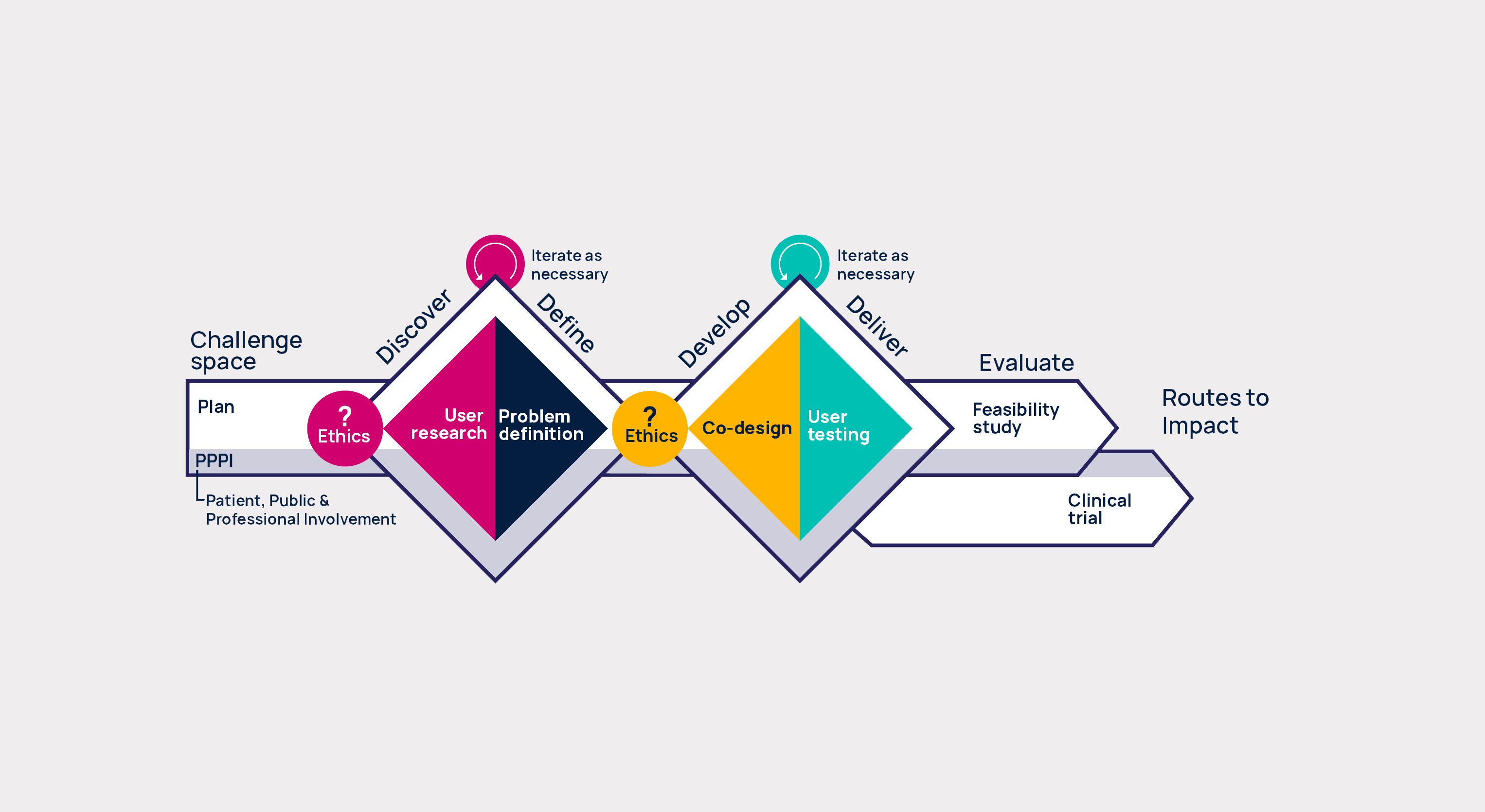

Our process
We have developed our own version of the Design Council's well-known Double Diamond design process to reflect the way we run design-led projects within healthcare.
It is worth noting that many of our projects are 'design-led', but Helix has a unique multi-disciplinary mix of Behavioural Science, Technological innovation, and Public Involvement as well as Human Centred Design, and underlying this simplified framework, we bring in frameworks from those disciplines.
Most projects do not fit perfectly into this framework, and a project can benefit from being open to the unexpected. Innovation is risky by nature, and it may be necessary to iterate phases of the process in order to reach the optimum result.
Challenge Space
With so much opportunity for improvement in healthcare, and a wealth of ideas (or problems to address), we take a lot of care to ensure challenge areas have a strong evidence base and clear unmet need that provides opportunity for impact.
Patient, Public & Professional Involvement
We involve representative members of the public, patients, and professionals in a meaningful way throughout our process to inform project strategy, from shaping funding applications and briefs, advising on involvement and engagement activities, to communication and dissemination of our work. We aim to involve a strategic, independent group of people with relevant lived experience alongside those we engage for user research, co-design, and evaluation. Their input will help shape how we approach the communities we design with and for, while also enhancing the diversity of perspectives in our projects and reducing bias. Our Public Involvement team have developed this Public Involvement Front Door web resource where you can access a range of useful advice and resources.
Ethics Approval
At suitable points in each project we evaluate whether the proposed work will require ethical approval from a relevant body. This could range from university ethics boards through to the Health Research Authority, or NHS service evaluations - depending on the nature of the work, who is involved, how they are recruited, and what data is needed.
Discover | User research
Discovery usually combines desk research with reaching out to a wide variety of stakeholders, including patients, families and professionals to get multiple perspectives on the challenge, how it may have been addressed elsewhere, and to ensure we have understood the brief as comprehensively as possible. This will often involve one-to-one interviews with representative users, and shadowing and observing people in their living and working environments. The outcome will usually be a report of the insights gathered, an iterated brief and/or project plan.
Define | Problem definition
The Define phase will involve synthesising our insights, user research and desk research, and evaluating it against the opportunities and resources available to address them. It will usually be a dialogue between project members, lay advisors and clients, funders, and partners to agree the optimum framing of the creative phase of the project against expected long term impact.
Develop | Co-design
The Develop phase is all about creating prototypes to test a hypothesis, and we aim to do this as iteratively as possible in quick cycles to rapidly evolve solutions. Prototypes may be provocations, designed to challenge assumptions, or incremental improvements to increase the chance of success for a promising solution. We always involve people we are designing with and for as appropriate to the project and subject matter. Co-design is an open dialogue between designers and users, with each party contributing in many roles. Diversity of people and ideas are encouraged and celebrated.
Deliver | User testing
The Deliver phase depends a lot on the chosen solution. It could focus on refining a usable prototype of a physical device, an advanced digital solution such as an app or communication strategy, or a service design manifested as a protocol with a range of supporting assets. The principal aim of the Deliver phase is to produce an evidence-based design solution that can be used for a formal evaluation.
Evaluate
We aim to evaluate outcomes from our designs in order to support the evidence base for adoption or policy change and different routes to impact. Some of our projects move into clinical trials and/or health economic evaluations that look at validated health outcomes and cost-benefit, whereas others may look at engagement, adherence, and adoption metrics or use qualitative feedback or simulation.
Routes to Impact
Throughout our process we iteratively assess and develop potential routes to impact by building the network and partnerships beyond our organisation to deliver the innovation to clinical practice. Some projects will have funders or partners at the outset that will directly deliver the impact, whereas projects supported by government research funding may be best delivered via a spin-out, license, or open-source collaboration.
Helix Centre Design Process © 2025 by Helix Centre Imperial College London is licensed under CC BY-SA 4.0



